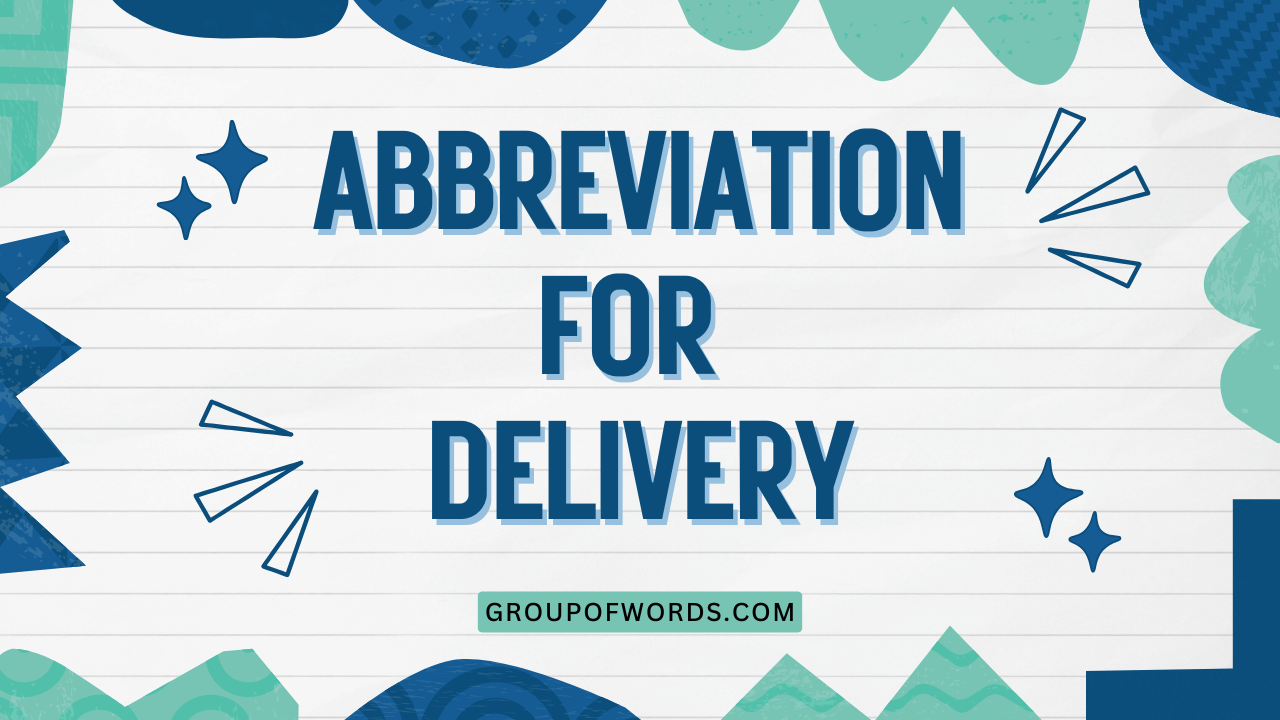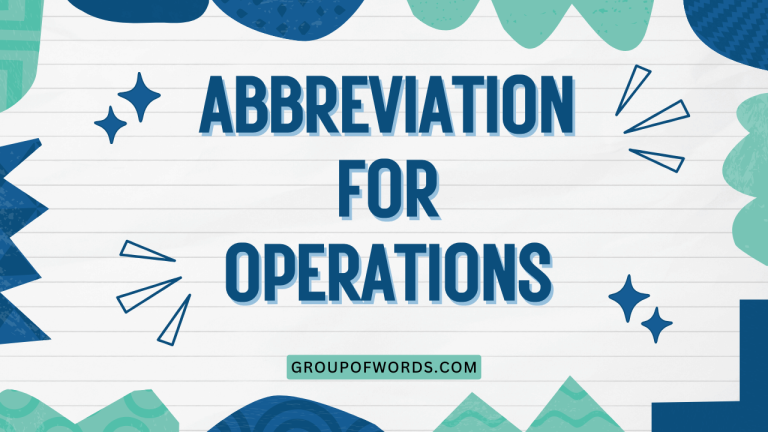Abbreviations for Delivery: A Comprehensive Guide
In today’s fast-paced world of e-commerce and logistics, abbreviations are essential for streamlining communication and ensuring efficient delivery services. Understanding these abbreviations is crucial for anyone involved in shipping, receiving, or managing deliveries.
This article provides a comprehensive guide to common abbreviations used in the delivery industry, explaining their meanings, usage, and importance. Whether you’re a business owner, logistics professional, or simply someone who frequently receives packages, this guide will equip you with the knowledge to navigate the world of delivery abbreviations with confidence.
Mastering these abbreviations will not only improve your understanding of delivery processes but also enhance communication with carriers and streamline your overall shipping and receiving operations. This article is designed for learners of all levels, from beginners to advanced English speakers, and provides practical examples, exercises, and tips to help you confidently use these abbreviations in everyday contexts.
Table of Contents
- Definition of Delivery Abbreviations
- Structural Breakdown of Delivery Abbreviations
- Types and Categories of Delivery Abbreviations
- Examples of Delivery Abbreviations
- Usage Rules for Delivery Abbreviations
- Common Mistakes with Delivery Abbreviations
- Practice Exercises
- Advanced Topics in Delivery Abbreviations
- Frequently Asked Questions (FAQ)
- Conclusion
Definition of Delivery Abbreviations
Delivery abbreviations are shortened forms of words or phrases commonly used in the logistics and shipping industries to communicate information quickly and efficiently. These abbreviations can represent various aspects of the delivery process, including shipping terms, service types, package characteristics, and delivery instructions.
The primary function of delivery abbreviations is to save time and space in written communication, especially in documents like shipping labels, tracking updates, and delivery notes. By using abbreviations, logistics professionals can convey essential information concisely, reducing the risk of errors and improving overall operational efficiency.
Delivery abbreviations are used in a wide range of contexts, including:
- Shipping documents (e.g., bills of lading, packing lists)
- Tracking systems and online portals
- Delivery notes and notifications
- Internal communication within logistics companies
- Customer service interactions
Structural Breakdown of Delivery Abbreviations
Delivery abbreviations typically follow a few common structural patterns, which can help in understanding and deciphering them. Here’s a breakdown of these patterns:
- Acronyms: Formed by taking the first letters of each word in a phrase (e.g., ETA for Estimated Time of Arrival).
- Initialisms: Similar to acronyms, but each letter is pronounced individually (e.g., COD for Cash on Delivery).
- Truncations: Shortening a word by removing letters, usually from the end (e.g., Addr. for Address).
- Contractions: Shortening a word by removing letters from the middle (e.g., Pkg for Package).
- Symbols: Using symbols to represent words or concepts (e.g., # for Number).
Understanding these structural elements can make it easier to recognize and interpret new or unfamiliar delivery abbreviations. For example, if you see an abbreviation starting with “Est,” it’s likely related to an estimation or estimate.
Many delivery abbreviations also incorporate numbers or other symbols to provide additional information. For instance, “2D” might refer to a two-day delivery service, while “Fragile!” indicates that the package requires careful handling.
Types and Categories of Delivery Abbreviations
Delivery abbreviations can be categorized based on the type of information they convey. Here are some common categories:
Shipping Terms
These abbreviations relate to the conditions and agreements surrounding the shipment of goods.
Service Types
These abbreviations indicate the specific type of delivery service being used.
Package Characteristics
These abbreviations describe the physical attributes of the package.
Delivery Instructions
These abbreviations provide specific instructions for the delivery person.
Location-Related
These abbreviations refer to places or positions in the delivery chain.
Time-Related
These abbreviations indicate specific times or durations.
Examples of Delivery Abbreviations
Here are some examples of delivery abbreviations, organized by category:
Shipping Terms
The following table provides examples of shipping term abbreviations, along with their meanings and example sentences.
| Abbreviation | Meaning | Example Sentence |
|---|---|---|
| FOB | Free On Board | The price is FOB origin, meaning the buyer pays for shipping from the seller’s location. |
| CIF | Cost, Insurance, and Freight | The CIF price includes the cost of the goods, insurance, and freight charges. |
| EXW | Ex Works | The EXW price only covers the cost of the goods at the seller’s premises. |
| DDP | Delivered Duty Paid | The DDP price includes all costs, including duties and taxes, to the buyer’s location. |
| DAP | Delivered At Place | The DAP price includes all costs to deliver the goods to a specified location. |
| C&F | Cost and Freight | The C&F price includes the cost of the goods and freight charges to a named port. |
| LCL | Less than Container Load | For smaller shipments, LCL is often more cost-effective than a full container. |
| FCL | Full Container Load | FCL shipments are typically more economical for large volumes of goods. |
| BL | Bill of Lading | The BL is a crucial document for international shipments, serving as a receipt and a contract. |
| AWB | Air Waybill | The AWB is the equivalent of a bill of lading for air freight. |
| ETA | Estimated Time of Arrival | The ETA for the shipment is next Tuesday. |
| ETD | Estimated Time of Departure | The ETD from the port is scheduled for tomorrow morning. |
| POD | Proof of Delivery | Please provide POD once the shipment has been delivered. |
| Incoterms | International Commercial Terms | Make sure you understand the Incoterms before finalizing the shipping agreement. |
| Whs | Warehouse | The goods are currently being stored at our Whs. |
| Consign. | Consignment | The goods are sent on Consign., meaning payment is due after they are sold. |
| Cust. | Customs | The shipment is currently held at Cust. for inspection. |
| Imp. | Import | The Imp. duties must be paid before the goods can be released. |
| Exp. | Export | The Exp. documentation needs to be completed accurately. |
| Trans. | Transit | The goods are currently in Trans. between warehouses. |
| Deliv. | Delivery | The Deliv. is scheduled for tomorrow. |
| P/P | Prepaid | The shipping charges are P/P by the sender. |
| C.O.D. | Cash on Delivery | We accept C.O.D. payments for this order. |
| Ins. | Insurance | We recommend purchasing Ins. for valuable items. |
Service Types
The following table provides examples of service type abbreviations, along with their meanings and example sentences.
| Abbreviation | Meaning | Example Sentence |
|---|---|---|
| 2D | Two-Day Delivery | We offer 2D shipping for most items. |
| OD | Overnight Delivery | If you need it urgently, choose OD at checkout. |
| STD | Standard Delivery | STD usually takes 3-5 business days. |
| EXP | Express Delivery | EXP will get your package there faster than standard. |
| PRI | Priority Mail | PRI includes tracking and insurance. |
| FF | Freight Forwarding | We specialize in FF for international shipments. |
| LTL | Less Than Truckload | LTL is a cost-effective option for smaller freight shipments. |
| FTL | Full Truckload | FTL is ideal for large shipments that fill an entire truck. |
| Same Day | Same Day Delivery | Same Day service is available in select cities. |
| Next Day | Next Day Delivery | Next Day guarantees delivery by the end of the next business day. |
| GND | Ground Delivery | GND is the most economical shipping option. |
| RS | Return Service | Use RS if you need to return an item. |
| Sig. Req. | Signature Required | Sig. Req. ensures the package is delivered to the intended recipient. |
| Direct Del. | Direct Delivery | Direct Del. means the package will be delivered straight to the recipient’s address. |
| P.O. Box | Post Office Box | We ship to P.O. Box addresses. |
| APO/FPO | Army Post Office/Fleet Post Office | We ship to APO/FPO addresses for military personnel. |
| Int’l | International | Int’l shipping rates vary depending on the destination. |
| Dom. | Domestic | Dom. shipping is generally faster than international. |
| Oversize | Oversize Delivery | Oversize packages require special handling and may incur additional fees. |
| Expedited | Expedited Delivery | Expedited shipping ensures faster transit times for urgent deliveries. |
| Stnd. | Standard | Stnd. shipping is the default and most economical delivery option. |
| SP | Standard Post | SP is a type of surface mail, offering cost-effective but slower delivery. |
| PM | Priority Mail | PM offers faster delivery than standard post with included tracking. |
| FC | First Class | FC is a reliable option for lighter packages and documents. |
| Media Mail | Media Mail | Media Mail provides affordable shipping for books, music, and other media items. |
Package Characteristics
The following table provides examples of package characteristic abbreviations, along with their meanings and example sentences.
| Abbreviation | Meaning | Example Sentence |
|---|---|---|
| Fragile | Fragile | Mark the package as “Fragile” to ensure careful handling. |
| Hvy | Heavy | This box is Hvy, so please use caution when lifting. |
| Lght | Light | Since the package is Lght, it shouldn’t cost too much to ship. |
| Dims | Dimensions | Please provide the Dims of the package for accurate shipping quotes. |
| Wt | Weight | The Wt of the package is 5 lbs. |
| Vol. | Volume | The Vol. of the shipment is significant and will affect shipping costs. |
| Box | Box | The item will be shipped in a Box. |
| Ctn | Carton | Each Ctn contains 24 units. |
| Env | Envelope | The document will be sent in an Env. |
| Pallet | Pallet | The goods will be shipped on a Pallet. |
| Pkg | Package | The Pkg is scheduled to arrive tomorrow. |
| Qty | Quantity | The Qty ordered is 10 pieces. |
| Size | Size | Please specify the Size of the item. |
| L | Large | This is a L size package. |
| M | Medium | We need a M-sized box for shipping. |
| S | Small | The item fits in a S envelope. |
| HD | Handle with care | The package should be marked with HD to prevent damage. |
| Perishable | Perishable Goods | The shipment contains Perishable items and requires refrigeration. |
| Hazmat | Hazardous Materials | Hazmat items require special packaging and documentation. |
| ODO | Over, short and damaged | Please report any ODO items upon arrival. |
| Stackable | Stackable | These boxes are Stackable, so they can be placed on top of each other during transit. |
| Non Stackable | Non Stackable | The package must be marked Non Stackable to prevent crushing. |
| Oversized | Oversized | The package is Oversized and may require special handling. |
| Irregular | Irregular Shape | Due to its Irregular shape, the package may be subject to additional fees. |
| Cubic Ft | Cubic Feet | The total volume of the shipment is measured in Cubic Ft. |
Delivery Instructions
The following table provides examples of delivery instruction abbreviations, along with their meanings and example sentences.
| Abbreviation | Meaning | Example Sentence |
|---|---|---|
| Leave @ Door | Leave at Door | Please Leave @ Door if no one is home. |
| Sig. Req. | Signature Required | Sig. Req. ensures the package is delivered to the right person. |
| W/Neighbor | With Neighbor | If I’m not home, leave W/Neighbor at #10. |
| Call Bef. Del. | Call Before Delivery | Please Call Bef. Del. to confirm the delivery time. |
| Do Not Bend | Do Not Bend | The package is marked as Do Not Bend to protect the contents. |
| Handle with Care | Handle with Care | The package is marked as Handle with Care to prevent damage. |
| Deliver to Back Door | Deliver to Back Door | Please Deliver to Back Door if the front door is inaccessible. |
| Ring Bell | Ring Bell | Please Ring Bell upon arrival. |
| Text on Arrival | Text on Arrival | Please Text on Arrival so I can meet you. |
| Hold for Pickup | Hold for Pickup | I’ll Hold for Pickup at the local depot. |
| Attn: | Attention | Please address the package Attn: John Smith. |
| Floor # | Floor Number | Deliver to Floor # 3, Suite 301. |
| Apt # | Apartment Number | The Apt # is 2B. |
| Ste # | Suite Number | Deliver to Ste # 100. |
| Bldg # | Building Number | The Bldg # is 123 Main Street. |
| Dry Storage | Dry Storage Required | The shipment requires Dry Storage to prevent moisture damage. |
| Temp Controlled | Temperature Controlled | Temp Controlled environment is needed during transit. |
| Secure Location | Secure Location Needed | The package should be delivered to a Secure Location to prevent theft. |
| No Signature Required | No Signature Required | No Signature Required for the delivery. |
| PTO | Put Through Opening | Please PTO through the letterbox. |
| Confirm Del. | Confirm Delivery | Please Confirm Del. by sending a text. |
| Leave in Shed | Leave in Shed | Leave in Shed if no one is home. |
| Under Porch | Leave Under Porch | The package can be left Under Porch. |
| Direct Recipient | Direct Recipient Only | Direct Recipient Only, no substitutes. |
| Deliver Before 5 PM | Deliver Before 5 PM | The package must be Deliver Before 5 PM. |
Usage Rules for Delivery Abbreviations
When using delivery abbreviations, it’s important to follow certain rules to ensure clarity and avoid confusion:
- Use only widely recognized abbreviations: Stick to abbreviations that are commonly used and understood in the industry.
- Be consistent: Use the same abbreviation consistently throughout a document or communication.
- Provide context: If using an abbreviation that might be unfamiliar to the recipient, provide the full term the first time it’s used, followed by the abbreviation in parentheses.
- Avoid ambiguity: Some abbreviations can have multiple meanings. Ensure that the context makes the intended meaning clear.
- Consider your audience: When communicating with customers or individuals outside the logistics industry, use abbreviations sparingly or provide explanations.
It’s also important to be aware of industry-specific standards and regulations regarding the use of abbreviations. Some companies or organizations may have their own preferred abbreviations or guidelines.
Common Mistakes with Delivery Abbreviations
Here are some common mistakes to avoid when using delivery abbreviations:
- Using unfamiliar abbreviations: Using abbreviations that are not widely recognized can lead to confusion and delays.
- Misinterpreting abbreviations: Failing to understand the meaning of an abbreviation can result in errors in communication and operations.
- Overusing abbreviations: Using too many abbreviations can make communication difficult to understand, especially for those unfamiliar with the industry.
- Inconsistent usage: Using different abbreviations for the same term or concept can create confusion and inconsistency.
Here are some examples of incorrect and correct usage:
| Incorrect | Correct | Explanation |
|---|---|---|
| “Send the pkg ASAP.” | “Send the package ASAP.” | “Pkg” is acceptable, but “package” is clearer for general audiences. |
| “The shpmt is late.” | “The shipment is late.” | “Shipment” is the full word and avoids ambiguity. |
| “Use 2D shpng.” | “Use 2-day shipping.” or “Use 2D shipping.” | Be consistent with abbreviations; spell out if unsure. |
| “Deliver @ frnt dr.” | “Deliver @ front door.” | “Front door” is clearer than “frnt dr.” |
Practice Exercises
Test your knowledge of delivery abbreviations with these practice exercises:
Exercise 1: Matching
Match the abbreviation with its meaning.
| Abbreviation | Meaning |
|---|---|
| 1. ETA | a. Cash on Delivery |
| 2. COD | b. Proof of Delivery |
| 3. POD | c. Estimated Time of Arrival |
| 4. FOB | d. Free On Board |
| 5. OD | e. Overnight Delivery |
Answers: 1-c, 2-a, 3-b, 4-d, 5-e
Exercise 2: Fill in the Blanks
Fill in the blanks with the correct abbreviation.
| Sentence | Answer |
|---|---|
| 1. The customer will pay _________ upon delivery. | COD |
| 2. We offer _________ shipping for urgent orders. | OD |
| 3. Please provide _________ once the package is delivered. | POD |
| 4. The _________ for the shipment is tomorrow. | ETA |
| 5. The price is _________ origin. | FOB |
| 6. Please mark the package as _________ to prevent damage. | Fragile |
| 7. The _________ of the package is 10 lbs. | Wt |
| 8. Deliver to _________ if no one is home. | Leave @ Door |
| 9. Please _________ before delivery. | Call Bef. Del. |
| 10. The item will be shipped in a _________. | Box |
Exercise 3: True or False
Determine whether the following statements are true or false.
| Statement | Answer |
|---|---|
| 1. ETA stands for Estimated Time of Departure. | False |
| 2. COD means Cash on Delivery. | True |
| 3. FOB includes the cost of shipping to the buyer’s location. | False |
| 4. OD is a type of overnight delivery service. | True |
| 5. Fragile indicates that the package requires careful handling. | True |
| 6. Wt refers to the volume of a package. | False |
| 7. Sig. Req. means ‘Signature Required’. | True |
| 8. “Leave @ Door” means to deliver the package to a neighbor. | False |
| 9. “Call Bef. Del.” means to call the recipient before making the delivery. | True |
| 10. “Box” is the abbreviation for ‘envelope’. | False |
Advanced Topics in Delivery Abbreviations
For advanced learners, here are some more complex aspects of delivery abbreviations:
- Industry-specific abbreviations: Different industries may use unique abbreviations related to their specific products or services.
- Regional variations: Some abbreviations may have different meanings or usage in different regions or countries.
- Evolving abbreviations: New abbreviations are constantly being created as the logistics industry evolves.
- Legal and regulatory considerations: Certain abbreviations may have legal or regulatory implications, especially in international shipping.
Staying up-to-date with industry trends and best practices is essential for mastering advanced topics in delivery abbreviations.
Frequently Asked Questions (FAQ)
Here are some frequently asked questions about delivery abbreviations:
- What is the most important delivery abbreviation to know?
ETA (Estimated Time of Arrival) is crucial for tracking shipments and managing expectations. - How can I find out the meaning of an unfamiliar delivery abbreviation?
Consult industry glossaries, online resources, or ask a logistics professional for clarification. - Are delivery abbreviations standardized across all companies?
While many abbreviations are widely used, some companies may have their own internal abbreviations. - Is it okay to use delivery abbreviations when communicating with customers?
Use abbreviations sparingly and provide explanations when necessary to avoid confusion. - What should I do if I’m unsure about the meaning of a delivery abbreviation?
Always ask for clarification to avoid misunderstandings or errors. - Can the meaning of delivery abbreviations change over time?
Yes, as the logistics industry evolves, new abbreviations may emerge and existing ones may change in meaning. It is important to stay updated with the latest trends. - What are Incoterms and why are they important?
Incoterms (International Commercial Terms) are a set of standardized trade terms defining the responsibilities of sellers and buyers in international transactions. Understanding them is vital to avoid disputes over costs and liabilities in international shipping. - What is the difference between LCL and FCL shipping?
LCL (Less than Container Load) is a shipping option for smaller consignments that do not fill an entire container, while FCL (Full Container Load) refers to shipments occupying an entire container. Choosing between LCL and FCL depends on the size and volume of the shipment.
Conclusion
Understanding delivery abbreviations is essential for effective communication and efficient operations in the logistics and shipping industries. By mastering these abbreviations, you can streamline your workflow, reduce errors, and improve overall productivity.
This comprehensive guide has provided you with the knowledge and resources to confidently navigate the world of delivery abbreviations.
Remember to practice regularly, stay updated with industry trends, and always prioritize clarity and accuracy in your communication. With consistent effort, you’ll become proficient in using delivery abbreviations and enhance your effectiveness in the logistics field.






